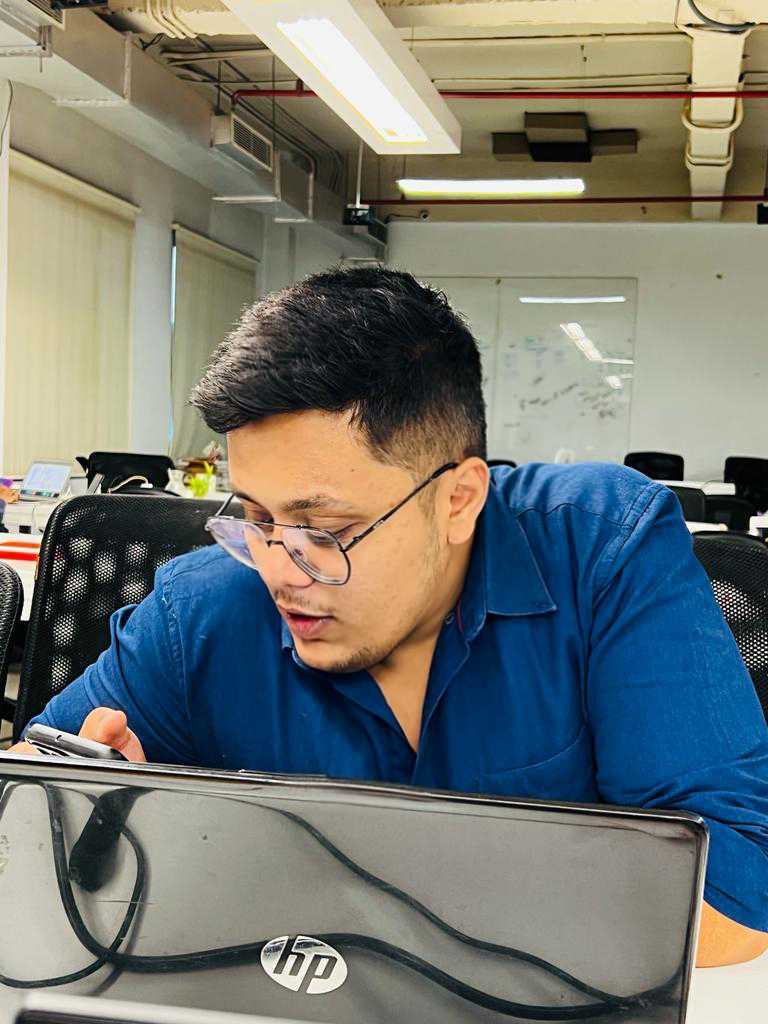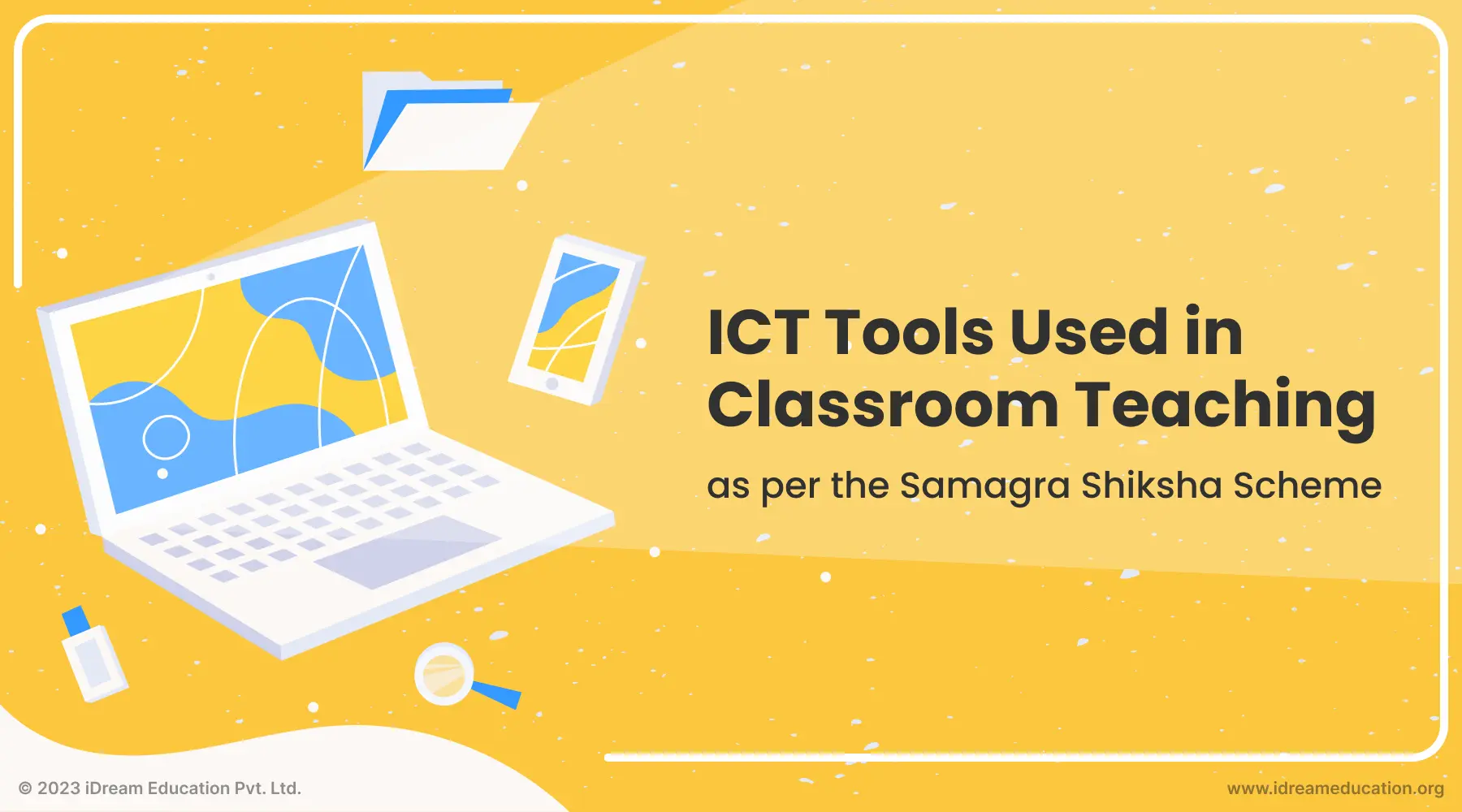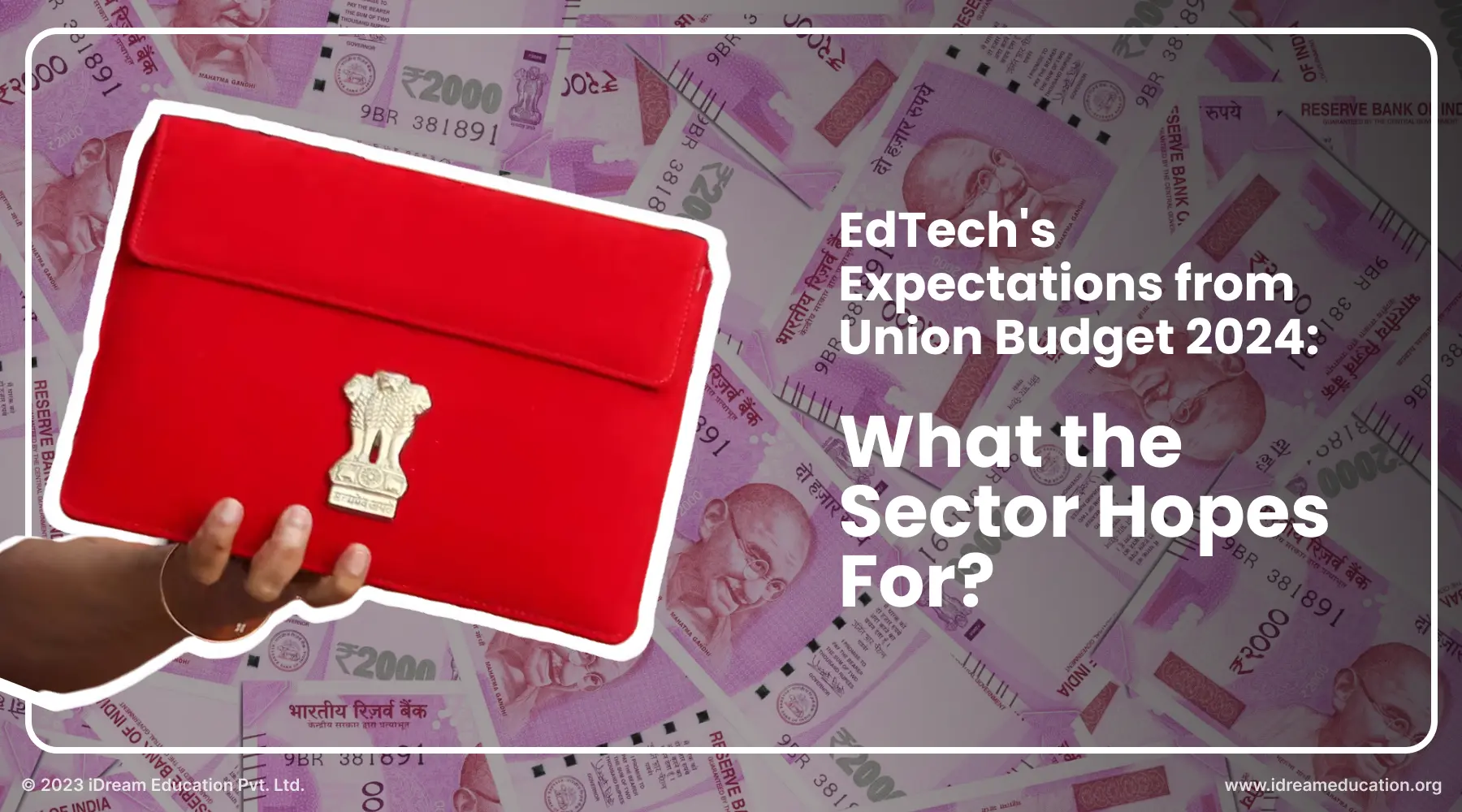Rashtriya Madhyamik Shiksha Abhiyan (RMSA): Complete Breakdown
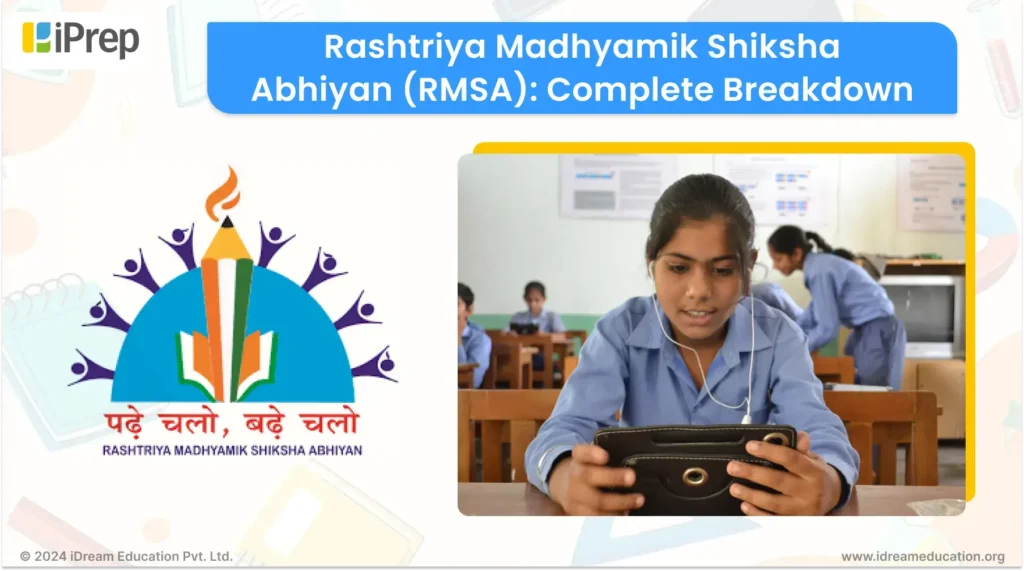
Commencing a paradigmatic journey, the Rashtriya Madhyamik Shiksha Abhiyan (RMSA) serves as an exemplar of advancement within the domain of secondary education in India. Since its establishment in March 2009, this endeavor has brought a huge transformation in the education landscape. It has fundamentally altered the educational terrain with each of its versions. Established on the principle that education possesses the potential to reshape prospects, RMSA has consistently endeavored to surpass traditional boundaries by encompassing all aspects of the academic journeys of Indian School Students.
As we look more closely at RMSA’s main goals, which range from increasing enrollment to promoting equity and inclusion in education, it becomes clear that it’s more than just an idea; it’s a promise to bring about change. This detailed analysis shows how RMSA has changed over time, what effects it has had, and what its future holds. It looks at its path to changing education in India. In this complete breakdown, we’ll get to the heart of RMSA. We’ll altogether learn about its goals, break down the impact it created, and find ways to use digital education to make its transformative effects even stronger. Let’s start by understanding what exactly is Rashtriya Madhyamik Shiksha Abhiyan RMSA.
What is Rashtriya Madhyamik Shiksha Abhiyan?
Initiated in March 2009, the Rashtriya Madhyamik Shiksha Abhiyan (RMSA) is a groundbreaking initiative of the Indian government. This endeavor is an important turning point in the history of secondary education. The primary objective of this initiative was to transform and enhance the standard of secondary education, guaranteeing that it is not only readily available but also economically viable for students from all corners of the nation, irrespective of their socioeconomic background.
The foundation of RMSA was firmly established on the premise that education possesses a profound capacity for change. This change transcends physical classrooms and textbooks, permeating every aspect of a student’s academic trajectory. With a multifaceted approach, the RMSA endeavored to tackle numerous crucial facets of education, pursuing the holistic development of each learner in addition to academic excellence. It aimed to ultimately make quality education accessible to all and reach as much student enrollment in schools as possible. The Rashtriya Madhyamik Shiksha Abhiyan’s definition of quality education involved emphasis on five main parameters. Let’s understand what those areas were:
Five Major Focus Areas of Rashtriya Madhyamik Shiksha Abhiyan
The major focus areas of Rashtriya Madhyamik Shiksha Abhiyan involved:
- Access: Guaranteeing equitable access to secondary education for all young individuals, situated within a reasonable distance from their residences. This requires the elimination of gender, socioeconomic, and geographical barriers to education.
- Equity: Equity entails the provision of focused assistance to underprivileged populations, such as girls, children from backward or rural areas, and students with disabilities, to rectify disparities in access and academic achievements.
- Quality Of Learning: Giving every student a top-notch education that gives them the values, abilities, and knowledge they need to succeed in life. Curriculum, pedagogy, teacher preparation, and infrastructure are all prioritized in this.
- Relevancy: Adapting instruction to students’ needs and 21st-century requirements. This entails introducing technology, life skills, and career training into the curriculum.
- Inclusiveness: Establishing a friendly, accepting, and inclusive learning environment where all students are valued and accepted regardless of their backgrounds or skill levels is known as inclusiveness. This entails encouraging tolerance and understanding as well as making accommodations for students with disabilities.
Altogether, with these in focus, the Rashtriya Madhyamik Shiksha Abhiyan (RMSA) aimed to enhance the reality of education in India. Let’s now discuss the core objective of Rashtriya Madhyamik Shiksha Abhiyan (RMSA) in detail.
The Core Objectives of Rashtriya Madhyamik Shiksha Abhiyan (RMSA)
Rashtriya Madhyamik Shiksha Abhiyan (RMSA) objectives have been evolving with time. With each of its versions, the Abhiyan has experienced adjustments during its execution, adjusting its goals to meet changing demands and overcoming new obstacles. Here is a breakdown of the main objectives for each version:
Objectives OF Rashtriya Madhyamik Shiksha Abhiyan (RMSA) Version 1 (2009-2014):
1. Increase Gross Enrollment Ratio (GER) in secondary education to 75% by 2014
Rashtriya Madhyamik Shiksha Abhiyan sought to ensure greater participation in this crucial stage of education by raising the secondary school Gross Enrollment Ratio (GER) to 75% by 2014.
2. Universalize access to secondary education for all children aged 14-18
The RMSA program further aimed to meet the educational needs of all children aged 14 to 18, regardless of their socioeconomic background, with a focus on inclusivity.
3. Improve the quality of education
- Enhance teacher training and development: Rashtriya Madhyamik Shiksha Abhiyan (RMSA) invested in extensive programs for teacher training and development to improve the methods and abilities of instruction.
- Develop and update curriculum and textbooks: By creating and updating curricula and textbooks and bringing them into line with current educational standards, the initiative aims to ensure a modern and relevant education system.
- Improve infrastructure and learning environment: To support students’ holistic development, RMSA worked to improve learning environments and infrastructure. Altogether, the intention behind this improvement of the educational experience was to benefit all students.
4. Promote equity and inclusion
- Focus on girls’ education, disadvantaged groups, and children with disabilities: To address socioeconomic disparities, the program specifically targeted marginalized groups and promoted equal educational opportunities for girls, as well as for children with disabilities and underprivileged communities.
- Address regional disparities in educational access and quality: further, the goal of the RMSA version 1 was to close these gaps by guaranteeing that all geographic areas have equal access to education and by minimizing differences between various regions.
Objectives OF Rashtriya Madhyamik Shiksha Abhiyan (RMSA) Version 2 (2014-2018):
1. Consolidate achievements of Version 1 and address remaining gaps
The main goal of Rashtriya Madhyamik Shiksha Abhiyan (RMSA) Version 2 was to improve overall educational outcomes by building on the achievements of its predecessor, Version 1. This required a thorough analysis of the prior successes and a focused strategy to address any remaining problems or gaps in the educational system.
2. Strengthen school leadership and management
- Provide training and support for school principals: Strengthening school administration and leadership was one of the main goals. This meant giving school principals specific training and assistance so they could acquire the abilities needed for efficient leadership.
- Improve school planning and monitoring processes: Furthermore, the initiative’s version 2 aimed to enhance educational governance and streamline administration by optimizing school planning and monitoring procedures.
3. Focus on skill development
- Integrate vocational and life skills training into the curriculum: The initiative recognized the value of equipping students for obstacles they may face in the real world and worked to incorporate life skills and vocational training into the curriculum.
- Develop strong linkages with industry and employers: To improve students’ employability, RMSA Version 2 also sought to forge strong ties with businesses and employers by coordinating educational programs with the changing demands of the labor market.
4. Strengthen ICT integration in education
- Provide digital infrastructure and resources to schools: Information and communication technology (ICT) integration in the classroom was on top priority in RMSA Version 2. This entailed supplying schools with the necessary digital tools and infrastructure to create a setting that is favorable to learning technology.
- Train teachers in using technology for teaching and learning: Concurrently, the program sought to provide educators with the required abilities, guaranteeing efficient use of technology for instruction and learning, and raising the standard of education as a whole.
Objectives OF Rashtriya Madhyamik Shiksha Abhiyan (RMSA) Version 3 (2020-Present):
1. Continue improving the Gross Enrolment Rate (GER) and universalize access to secondary education
Rashtriya Madhyamik Shiksha Abhiyan (RMSA) version 3 aimed to achieve greater inclusivity in the education system by maintaining and raising the Gender Enrollment Rate and stressing the significance of providing greater access to secondary education for all.
2. Further, enhances the quality of education
- Emphasis on continuous professional development for teachers: Rashtriya Madhyamik Shiksha Abhiyan (RMSA) Version 3 placed a high priority on teachers’ ongoing professional development to improve the efficiency of instruction being delivered in schools.
- Development of subject-specific pedagogy and innovative teaching methods: The initiative aimed to improve the quality of education by focusing on the development of pedagogy that was specific to a given subject and implementing innovative teaching techniques.
- Focus on student-centered learning and critical thinking skills: with this version, the development of critical thinking abilities and student-centered learning strategies were also on priority.
3. Strengthen school governance and community participation
Rashtriya Madhyamik Shiksha Abhiyan (RMSA) Version 3 sought to reinforce school governance structures in recognition of the critical role that governance plays in the education sector. Furthermore, the initiative aimed to promote community involvement in school matters, cultivating a cooperative and collaborative approach to educational decision-making.
4. Promote social and emotional learning (SEL) and mental well-being of students
The integration of social and emotional learning (SEL) into the curriculum was one of the main goals of Rashtriya Madhyamik Shiksha Abhiyan (RMSA) Version 3. This program addressed both academic and mental health aspects of student development to promote holistic learning. Programs came up to increase mental health awareness and offer the assistance that is required.
5. Integration of emerging technologies in education and school administration
Rashtriya Madhyamik Shiksha Abhiyan (RMSA) Version 3 aimed to incorporate emerging technologies into the educational system to stay up to date with technological advancements. This involved putting technology to use for effective school management, with the ultimate objective being the modernization of educational procedures and the provision of a more technologically advanced learning environment for students.
Keeping all that in mind, there is one thing for certain, the Rashtriya Madhyamik Shiksha Abhiyan surely has a strong agenda and a set of objectives that will surely change the the reality of the educational landscape of our country. RMSA for its 14 years of existence has had a significant impact on the educational reality of our country. And, the impact is growing with time. Let us get a deeper look into the impact of RMSA till now.
Impact Of Rashtriya Madhyamik Shiksha Abhiyan (RMSA)
The Rashtriya Madhyamik Shiksha Abhiyan (RMSA) has had some significant impact since its commencement. Let’s unfold some significant achievements one by one
Increased Access to Secondary Education:
- Enrollment rate at the secondary level: The Gross Enrollment Rate (GER) at the secondary level experienced a substantial increase from 52.26% in the academic year 2005-06 to an impressive 79.6% in 2020-21, as per the District Information System for Education (DISE) report. This surge indicates a significant improvement in providing access to secondary education across the country.
- Enrollment rate at higher secondary level: The Gross Enrollment Rate (GER) at the higher secondary level also saw a commendable rise. One of the biggest improvements has been observed in GER at the higher secondary level, which has reached 51.4% in 2019-20 from 40.1% in 2012-13.
- Reduction in gender gap: The gender gap in enrollment at the secondary level witnessed a notable reduction, narrowing from 14.78% in 2005-06 to 7.04% in 2020-21, as reported by the DISE. The Gender Parity Index (GPI) at both secondary and higher secondary has improved during this period. Further, improvement of GPI has been most pronounced at the higher secondary level. This highlights successful efforts in promoting gender equality in access to education.
Enhancements to Educational Quality
- Teacher-Pupil Ratio (TPR): The Rashtriya Madhyamik Shiksha Abhiyan (RMSA) provides evidence of a deliberate effort to improve the quality of education through the establishment of a more favorable teacher-student ratio, as evidenced by the decrease in the teacher-pupil ratio (TPR) from 43:1 in 2009-10 to 28:1 in 2020-21. This means that earlier, for every 43 students we had 1 teacher, but now we have one for every 28 students.
- Appointment of New Teachers: The RMSA website states that since 2009, over 8 lakh additional teachers have been appointed throughout India. This action signifies an effort to meet staffing requirements and ensure that students have sufficient assistance in their educational pursuits.
- Establishment Of Science Laboratories: Since 2009, the RMSA reports that more than one lakh science laboratories have been established in secondary schools. This development indicates an increased emphasis on science education, specifically in terms of practical and hands-on learning experiences.
- Infrastructure and information and communication technology (ICT): The RMSA reports specify that to enhance educational methods and results, more than 8 lakh computers are provided to schools, and the respective teachers in these schools have received concurrent training on ICT integration.
- Focus on Science, Math & English: The commitment to enhancing foundational skills in Science, Math, and English is evident in RMSA. The same can be seen in the allocation of resources and implementation of specialized initiatives that aim to improve teaching and learning in these vital subjects.
Other Significant Accomplishments Of RMSA
- Enhanced physical infrastructure: Since the commencement of RMSA we have seen various establishments of additional classrooms, schools, lavatories, and drinking water facilities. This, enhances the physical infrastructure of academic establishments as a whole, thereby fostering an environment that is conducive to learning.
- Prioritization of inclusion: By providing specialized interventions to cater to the unique learning requirements of children with disabilities and those hailing from disadvantaged backgrounds, RMSA has worked for and has exemplified its dedication to inclusive education.
- Teacher training and development: An ongoing endeavor to improve the professional growth of Teachers. This is reflected in RMSA’s implementation of routine in-service training programs for teachers. These programs cover diverse facets of pedagogy and content knowledge.
- Strengthening School Management: RMSA Brought in an all-encompassing strategy for enhancing the overall governance and management of schools. It was further exemplified by capacity-building initiatives for administrators and support for school management committees.
Chronology of Some Significant Accomplishments Of Rashtriya Madhyamik Shiksha Abhiyan (RMSA)
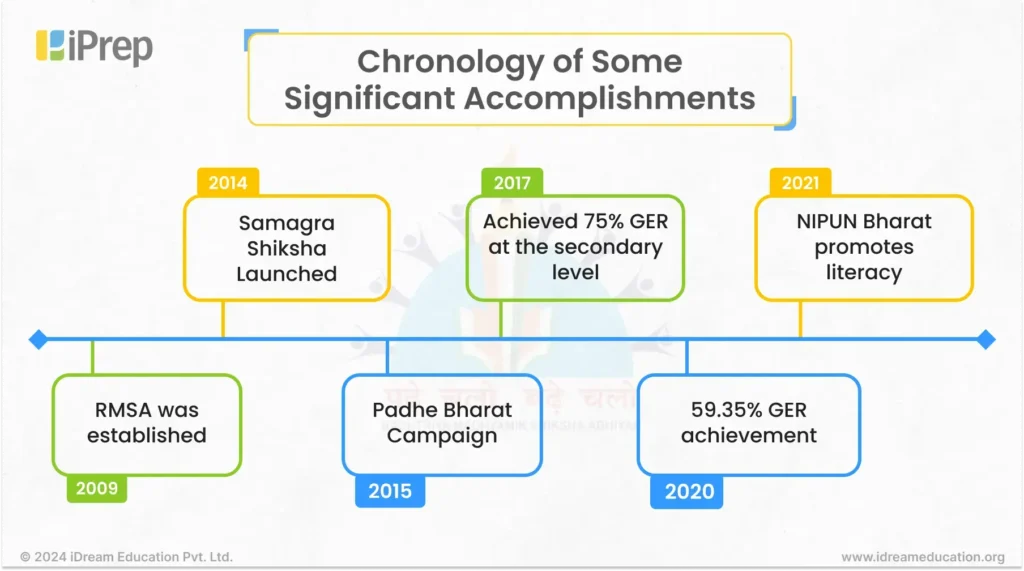
- In 2009, the Rashtriya Madhyamik Shiksha Abhiyan (RMSA) was established to achieve universal secondary education access.
- 2014 marked the inception of Samagra Shiksha, an initiative that streamlined endeavors towards comprehensive education reform by incorporating the RMSA and several other education schemes.
- In 2015, the “Padhe Bharat Badhe Bharat Campaign” was initiated to improve fundamental literacy and numeracy abilities, thereby establishing a solid foundation for academic achievement.
- Achieving 75% GER at the secondary level in 2017: The achievement of a Gross Enrollment Ratio (GER) of 75% in secondary education indicates a rise in student engagement and participation.
- Attainment of 59.35% GER at the higher secondary level by 2020: The attainment of a Gross Enrollment Ratio of 59.35% at the higher secondary level signifies advancements in the effort to ensure accessibility to higher education.
- Launch of the “NIPUN Bharat” mission in 2021: The establishment of the “NIPUN Bharat” initiative in 2021 highlights the continuous dedication to attaining fundamental literacy and numeracy skills, thereby guaranteeing a solid academic groundwork for every individual.
All these together significantly show that the Rashtriya Madhyamik Shiksha Abhiyan has had a significant impact on the educational landscape of our country. However, this information was mainly sourced from the Unified District Information Commission For Education Plus (UDICE+) or the Ministry of Education. What about the ground reality? Altogether, how did schools, teachers, and, students react to Rashtriya Madhyamik Shiksha Abhiyan (RMSA)? For that we have the findings from a study conducted in the state of Madhya Pradesh covering the city of Indore, to assess the impact of Rashtriya Madhyamik Shiksha Abhiyan (RMSA)
Assessing The Impact of Rashtriya Madhyamik Shiksha Abhiyan (RMSA)
The study on Rashtriya Madhyamik Shiksha Abhiyan (RMSA)’s Impact in the Indore district found significant data on teachers’ competency and program success. Positive results include 100% of teachers using students’ prior knowledge to teach new concepts and 82% actively involving students in lesson prefaces. Teachers use Q&A, stories, and short dramas to spark student curiosity, and 96% use real-life examples.
The impact of RMSA on education quality is multifaceted. Teachers report increased classroom discipline (90%) and ethical accountability (86%). With 95% of teachers using objective questionnaires and 96% using surprise tests, the study shows positive changes in evaluation. Teaching methods are also changing, as 92% of teachers report increased attentiveness and 100% emphasize not limiting subject knowledge to textbooks.
Student attitudes toward teachers are positive, with 94% saying they prompt them to find answers, ask more questions, and provide remedial classes for learning difficulties. In addition, teachers use audio-visual aids and real-life examples, which 95% of students appreciate.
The study considers student, teacher, principal, and administrator opinions when assessing RMSA’s impact. The findings agree that school facilities, student achievement, and school attitudes have improved. For instance, 93% of students think teacher quality has improved and 87% see their achievements and participation rising. Further, the Physical improvements, curriculum development, and teacher competency training under RMSA benefit both teachers and principals.
All this data together showcases the positive on-ground impact of the Rashtriya Madhyamik Shiksha Abhiyan (RMSA). However, there is something that has the potential to amplify the impact of RMSA even further. Yes, we are talking about “Digital Education”. Digital education has the potential to significantly amplify the impact of the Rashtriya Madhyamik Shiksha Abhiyan (RMSA) and take the Abhiyan closer to achieving its objectives than ever before. How? Let’s have a look.
Digital Education: Enhancing the Impact of Rashtriya Madhyamik Shiksha Abhiyan (RMSA)
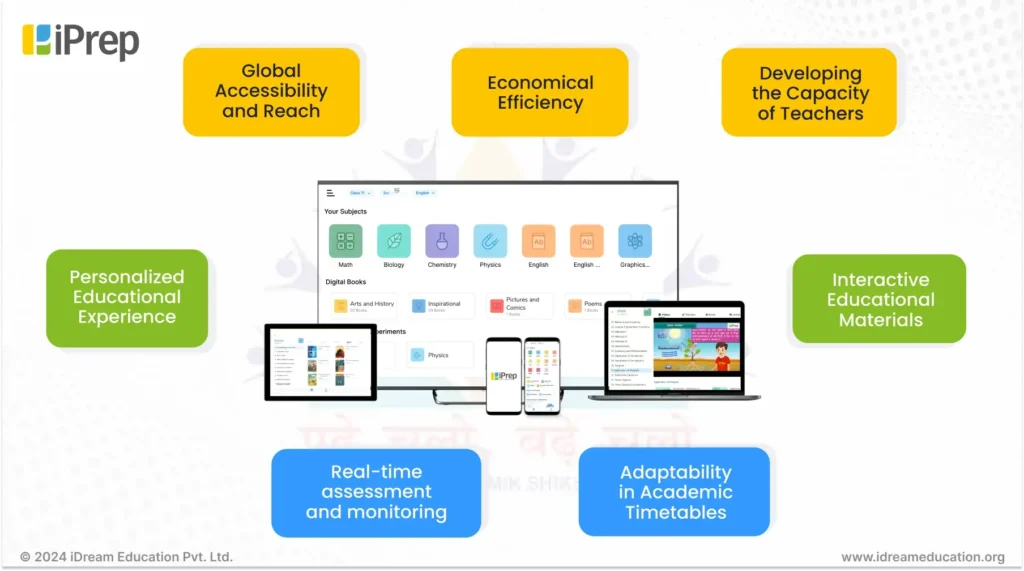
There are several ways in which Digital Education can enhance the Impact of RMSA. Let’s unfold them one by one.
Global Accessibility and Reach
The utilization of digital education platforms has the potential to greatly expand the outreach of the Rashtriya Madhyamik Shiksha Abhiyan (RMSA) in remote regions through the provision of high-quality educational materials. This measure further guarantees that students residing in remote areas are provided with equivalent educational opportunities as those in metropolitan areas.
Consider students in remote areas who do not have reliable internet access using tablets or laptops to access educational materials. This vision is realized through solutions such as the iPrep Digital Library and iPrep Tablets, which bring quality learning directly to their fingertips. All that, even when they are not connected to the internet. The digital learning solutions offered by iDream Education thus come with the ability to amplify the impact of Rashtriya Madhyamik Shiksha Abhiyan (RMSA) by helping the Abhiyan reach even the remotest of locations.
Personalized Educational Experience
Digital education facilitates the adaptation of instructional resources to accommodate the unique learning preferences and paces of individual students. By adopting a personalized approach, RMSA can effectively cater to the varied needs of its students, thereby facilitating an enhanced learning experience for every individual.
Tailoring education to individual needs is critical, and iDream Education embraces this through iPrep PAL, a personalized adaptive learning platform that adapts to each student’s pace and learning style. Consider a system that suggests content and personalized learning paths based on their strengths and weaknesses. Every student is now able to excel on their terms, maximizing their learning potential.
Economical Efficiency
Utilizing digital tools may ultimately result in cost savings. Through the reduction of physical infrastructure and printed material requirements, RMSA can enhance resource allocation efficiency. It thereby redirects financial investments towards critical areas. These involve teacher training and the improvement of educational quality.
Shifting to digital tools like those provided by iDream Education results in significant cost savings. Our resource-efficient platforms require little infrastructure and maintenance, which frees up funds for things like teacher training and curriculum development. This novel approach ensures that every rupee invested has a broader and more long-term impact on the educational landscape.
Real-time assessment and monitoring
Digital platforms permit the monitoring of student performance and progress in real-time. Educators and policymakers may require this information to determine areas for improvement, assess the efficacy of teaching strategies, and promptly modify interventions to guarantee improved educational outcomes under the Rashtriya Madhyamik Shiksha Abhiyan (RMSA).
Teachers need to have access to real-time information about their students’ progress and performance. Learning management systems from trusted EdTech providers such as iDream Education come with real-time progress monitoring. These solutions at every point record the usage of the digital learning content by the students or teachers and represent that analytically in the “My Reports” section of the learning platform.
The same can be synced to a centralized Reporting Dashboard which we call the iPrep Reporting Dashboard. That way, iDream Education’s Digital Learning solutions are implemented under the Rashtriya Madhyamik Shiksha Abhiyan (RMSA), and the administrators will be able to see the learning progress reports of all schools covered under the Abhiyan in one place.
Developing the Capacity of Teachers
Digital education affords educators the chance to engage in ongoing professional development and training. By participating in online workshops and courses, RMSA-accredited educators can remain current on the most recent pedagogical approaches, instructional strategies, and subject matter expertise, thereby improving the standard of education.
Ultimately, empowering teachers is key to effective digital learning implementation. Therefore, we at iDream Education deliver thorough teacher training sessions while implementing our digital learning solutions such as iPrep Digital Class or iPrep Digital Library. These training sessions revolve around showing teachers how to best use our solutions to deliver their classroom instruction, how to include the usage of these solutions in their lesson plans, and how to best use our solutions as a supplement to their teaching.
Interactive Educational Materials
Digital learning platforms provide multimedia-rich and interactive resources, which enhance the appeal and satisfaction of the educational experience. By integrating these resources into the RMSA curriculum, students’ enthusiasm for learning can peak. It thereby cultivates a favorable disposition toward education.
When it comes to Educational Materials, digital learning content offered by EdTech organizations such as iDream Education takes it one step further. With content categories such as animated video lessons, practice with instant feedback, interactive lessons, interactive simulations, and more, it takes the learning engagement levels to an all-time high.
Adaptability in Academic Timetables
Digital education facilitates adaptable study timetables. This caters to the varied situations of students covered by RMSA. That may also include those who may have the burden of familial or occupational obligations. This degree of adaptability has the potential to enhance overall student engagement and retention rates.
Schedules shouldn’t get in the way of learning. iDream Education always follows this idea by giving students mobility-friendly platforms and offline access options that they can access on their phones, tablets, laptops, etc. This meets a wide range of needs and situations, making sure that everyone can still easily access learning opportunities.
Now that we have discussed how digital education can enhance the impact of Rashtriya Madhyamik Shiksha Abhiyan, let’s list down the digital education solutions offered by iDream Education that can be a perfect fit for the purpose here
iDream Education’s Digital Learning Solutions for Enhancing RMSA Impact
- iPrep Digital Class: These are Interactive and engaging smart class solutions with preloaded curriculum-aligned content, multimedia resources, and engaging activities.
- iPrep Digital Library: This is a Smart ICT Lab solution for offline learning with tablets or notebooks loaded with educational content and progress monitoring features. These digital libraries for schools are accessible even without internet connectivity.
- iPrep PAL: This is a Personalized Adaptive Learning solution that helps every learner eradicate their learning gaps and achieve grade-appropriate competency. It assesses their current learning levels and creates personalized learning paths for them based on the analysis. The iPrep PAL has been Implemented statewide in Haryana schools under e-ADHIGAM, a NEP 2020-aligned initiative by Haryana’s Government. This personalized adaptive learning platform can also be implemented in combination with our Smart ICT LAB solution and that combined solution is called “PAL LAB“.
- iPrep Tablets: This is a learning tablet solution that can also be referred to as “Educational tablets for school students”. These are mainly used for bridging the digital divide with preloaded learning devices and monitoring tools to ensure consistent access and progress.
- iPrep App: This is a one-stop learning platform for K12 covering all subjects and streams for all grades in English, Hindi, and other regional languages. It also brings in a vast collection of holistic development-related content for students to learn and grow simultaneously.
Bonus
- iPrep Reporting Dashboard: Gain real-time insights into student-wise, class-wise, school-wise, project-wise, district-wise, or even state-wise learning performance progress through a centralized reporting dashboard.
- Teacher Training: Thorough teacher training sessions to equip teachers with the skills and knowledge needed to effectively integrate digital tools into their teaching practices.
Overall, iDream Education’s comprehensive suite of digital learning solutions is poised to significantly enhance the impact of RMSA by providing interactive, personalized, and accessible education solutions that cater to the diverse needs of students and educators alike.”
Let’s Conclude
In Conclusion, the Rashtriya Madhyamik Shiksha Abhiyan (RMSA) is a shining example of progress in India’s secondary education system. Since its start in 2009, this initiative has not only increased enrollment but also fought for equity, inclusion, and quality education. The different versions of RMSA show that the educational stakeholders behind it and the Abhiyan itself are receptive to change and adapt to meet the changing needs of the education system.
A closer look at the main goals and achievements of each version makes it clear that RMSA has permanently changed the way India teaches. In addition, access, gender equality, teacher-to-student ratios, and infrastructure improvements have all come a long way since RMSA began.
A closer look at the effects at the local level, like the study in Indore shows, shows that teacher skills, classroom behavior, and the overall quality of education have all gotten better. The success stories aren’t just numbers. They altogether, show how attitudes have changed, how engaged students are, and how teachers have been given more power.
What’s Ahead?
There is hope ahead that adding digital education to RMSA will make these accomplishments even better. iDream Education’s digital learning solutions, like iPrep Digital Class, iPrep Digital Library, iPrep PAL, and more, allow the facilitation of personalized, interactive, and easy-to-reach learning experiences. RMSA can have a bigger effect if it can reach people in remote areas, adapt to different learning styles, and improve teacher training through digital platforms and iDream Education can be a perfect partner for that.
Further, these ambitious goals of RMSA and the cutting-edge power of digital education can work together to make a powerful force for a better future for the school-going minds of India. We need to keep planting the seeds of knowledge and skills so that every student has the tools they need to do well in the 21st century. Rashtriya Madhyamik Shiksha Abhiyan’s journey is more than just a story of the past; it shows how education can change the course of a country’s history.

